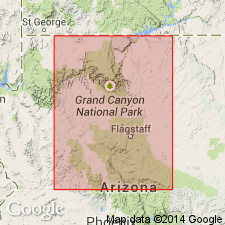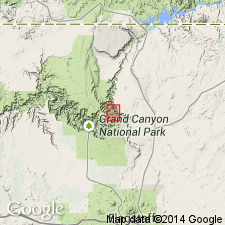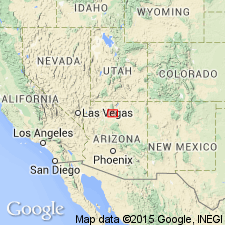
- Usage in publication:
-
- Carbon Butte Member
- Modifications:
-
- First used
- AAPG geologic province:
-
- Plateau sedimentary province
- Southern Rocky Mountain region
Summary:
First use of the Carbon Butte Member of the Kwagunt Formation of the Chuar Group. Age is late Precambrian.
Source: GNU records (USGS DDS-6; Menlo GNULEX).

- Usage in publication:
-
- Carbon Butte Member
- Modifications:
-
- [Principal reference]
- Revised
- Dominant lithology:
-
- Sandstone
- Shale
- AAPG geologic province:
-
- Plateau sedimentary province
- Southern Rocky Mountain region
Summary:
Pg. 1244 (table 1), 1250, 1257, geol. map (fig. 1), columnar section (fig. 2). Carbon Butte Member of Kwagunt Formation of Chuar Group. Upper part mostly shale with some thinner sandstone beds. Lower part chiefly massive red sandstone that forms prominent shelf. Total thickness at type about 251 feet (76 m), [252 feet in table 1]. Is lowest member of Kwagunt Formation (new). Upper and lower contacts are sharp. Underlies basal biohermal stromatolites of Awatubi Member (new) of Kwagunt. Overlies shales of Duppa Member (new) of Galeros Formation (new) of Chuar Group. Appears = Walcott's upper divisions 12 and 13 of Chuar terrane [USGS Ann. Rpt. 14, p. 508-509, 1894], and Hinds' division 6 and part of 7 of Chuar Group [Carnegie Inst. Washington Pub. 463, p. 105-106, 1936]. Age is late Precambrian.
Type section: Carbon Butte section E, [about 0.5 mi south-southwest of Carbon Butte, approx. Lat. 36 deg. 10 min. 03 sec. N., Long. 111 deg. 50 min. 36 sec. W., Cape Solitude 7.5-min quadrangle], eastern Grand Canyon, Grand Canyon National Park, Coconino Co., northern AZ.
Named from prominent shelf of red sandstone surrounding Carbon Butte, [about 1 mi west of Temple Butte and 2.5+ mi southwest of confluence of Colorado and Little Colorado Rivers, Lat. 36 deg. 10 min. 33 sec. N., Long. 111 deg. 50 min. 32 sec. W., Cape Solitude 7.5-min quadrangle], eastern Grand Canyon, Grand Canyon National Park, Coconino Co., northern AZ.
[Additional locality information from USGS GNIS database and USGS historical topographic map collection TopoView, accessed on September 22, 2024.]
Source: Publication.

- Usage in publication:
-
- Carbon Butte Member*
- Modifications:
-
- Adopted
- AAPG geologic province:
-
- Plateau sedimentary province
- Southern Rocky Mountain region
Summary:
Carbon Butte Member of the Kwagunt Formation of the Chuar Group of Ford and Breed (1973) is adopted as the Carbon Butte Member of the Kwagunt Formation of the Chuar Group of the Grand Canyon Supergroup. Age is late Precambrian.
Source: GNU records (USGS DDS-6; Menlo GNULEX).

- Usage in publication:
-
- Carbon Butte Member*
- Modifications:
-
- Age modified
- AAPG geologic province:
-
- Plateau sedimentary province
- Southern Rocky Mountain region
Summary:
Carbon Butte Member of Kwagunt Formation. Age modified from late Precambrian --to-- Proterozoic Y.
Source: Modified from GNU records (USGS DDS-6; Menlo GNULEX).

- Usage in publication:
-
- Carbon Butte Member*
- Modifications:
-
- Age modified
- AAPG geologic province:
-
- Plateau sedimentary province
- Southern Rocky Mountain region
Summary:
Carbon Butte Member of Kwagunt Formation of Chuar Group of Grand Canyon Supergroup. Basal member of Kwagunt Formation. Underlies Awatubi Member of Kwagunt. Overlies Duppa Member of Galeros Formation of Chuar. Thickness 49 m. Age changed from Proterozoic Y to Late Proterozoic (age term applied to rocks approximately 900 to 570 Ma). Change in age applies to Kwagunt and its (ascending) Carbon Butte, Awatubi, and Walcott Members in the Southern Rocky Mountain region of northern AZ. Shown as younger than 850 Ma (est). Columnar section.
Source: Modified from GNU records (USGS DDS-6; Denver GNULEX).
For more information, please contact Nancy Stamm, Geologic Names Committee Secretary.
Asterisk (*) indicates published by U.S. Geological Survey authors.
"No current usage" (†) implies that a name has been abandoned or has fallen into disuse. Former usage and, if known, replacement name given in parentheses ( ).
Slash (/) indicates name conflicts with nomenclatural guidelines (CSN, 1933; ACSN, 1961, 1970; NACSN, 1983, 2005, 2021). May be explained within brackets ([ ]).

